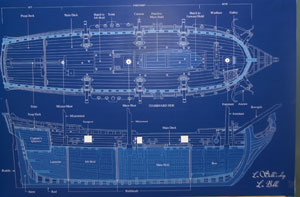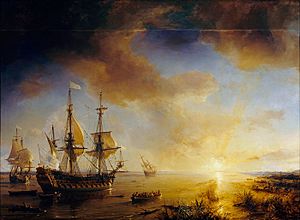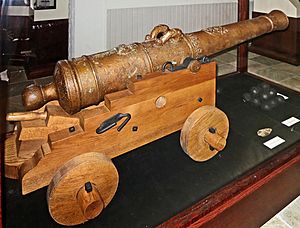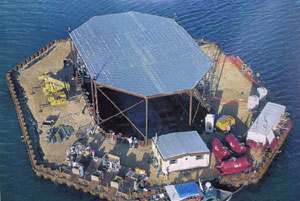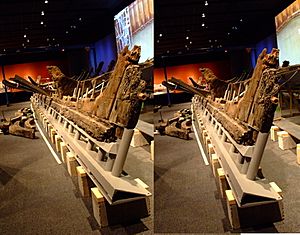La Belle (ship) facts for kids
class="infobox " style="float: right; clear: right; width: 315px; border-spacing: 2px; text-align: left; font-size: 90%;"
| colspan="2" style="text-align: center; font-size: 90%; line-height: 1.5em;" | 
|}
La Belle was one of the ships used by Robert de La Salle. He was a French explorer who led a mission to start a French colony in North America in 1685. His goal was to find the mouth of the Mississippi River in the Gulf of Mexico.
Sadly, La Belle was shipwrecked in 1686 in what is now Matagorda Bay, Texas. This disaster led to the failure of La Salle's colony. For centuries, the ship's remains were lost and forgotten. But in 1995, a team of archaeologists found the wreck. This discovery was a huge deal for Texas history. A major excavation followed, recovering the entire ship and over a million artifacts.
Contents
| History | |
|---|---|
| Name | La Belle |
| Owner | Louis XIV |
| Operator | René-Robert Cavelier, Sieur de La Salle |
| Builder | Honoré Mallet |
| Fate | shipwrecked |
| General characteristics | |
| Type | barque longue |
| Tonnage | 40–45 |
| Length | 54 ft 4 in (16.56 m) |
| Beam | 14 ft 9 in (4.50 m) |
| Draft | 8 ft (2.4 m) |
- Spanish Discovery
- Finding the Wreck Again
- Digging Up the Ship
- La Belle on Display
- Who Owns La Belle?
Why the French Explored Texas
In the late 1600s, many European countries claimed parts of North America. Spain controlled Florida and much of the southwestern continent. Britain claimed the northern Atlantic coast. France had a large area called New France, which included parts of modern-day Canada and the Illinois Country.
France worried that its colonies in the middle of the continent might be attacked. In 1681, a French nobleman named René-Robert Cavelier, Sieur de La Salle explored the Mississippi River. He hoped to find a path to the Pacific Ocean. Instead, he found a route to the Gulf of Mexico.
Even though Hernando de Soto had claimed this area for Spain earlier, La Salle claimed the Mississippi River valley for the French king, Louis XIV. He named the territory Louisiana in the king's honor. La Salle believed that French control of the Mississippi would divide Spanish lands. He also thought it was a good spot to attack Spanish silver mines. In 1683, King Louis XIV agreed to support La Salle's plan.
Building La Belle
La Salle first planned to sail to New France, then travel overland to the Illinois Country. From there, he would sail down the Mississippi River to his new colony. To carry his supplies, he needed a large ship for the Atlantic Ocean and a smaller one for the river. King Louis XIV gave La Salle two ships: Le Joly and La Belle.
La Belle was first built as a "kit." Its parts were numbered so they could be put together later. The idea was to load these pieces onto Le Joly, transport them to North America, and then assemble La Belle near the Mississippi River.
However, the king wanted the expedition to sail directly to the Gulf of Mexico. So, La Belle was assembled in France in less than two months. It was then prepared for its long journey across the ocean.
La Belle was a type of ship called a "barque-longue." It had three masts and could carry 40–45 tons of cargo. It was about 54 feet 4 inches (16.56 m) long and 14 feet 9 inches (4.50 m) wide. The ship was designed to be very easy to steer.
The Long Voyage
On July 24, 1684, La Salle left La Rochelle in France with four ships:
- Le Joly (a large warship)
- L'Aimable (a supply ship)
- La Belle (a barque)
- St. Francois (a small ketch)
Almost 300 people were on board, including soldiers, missionaries, merchants, and families. Sadly, the St. Francois, full of supplies, was captured by Spanish pirates.
In late 1684, the three remaining ships searched for the Mississippi River. They were warned about strong currents in the Gulf of Mexico. But due to inaccurate maps and La Salle's own mistakes, they missed the Mississippi. Instead, they landed far west in Matagorda Bay, Texas, in early 1685.
La Belle easily entered the bay. But L'Aimable got stuck on a sandbar. A bad storm hit, and they could only save some food, cannons, and a few other items. By March 7, L'Aimable had sunk. Le Joly returned to France, leaving La Belle as the only ship for the settlers.
| 4800 livres | dried meat or bacon |
| 2000 livres | gold, arms, tools |
| 2 livres | butter |
| 108 hundredweights | bread or flour |
| 90 hundredweights | powder and lead |
| 8 | pigs |
| 10 casks | wine or brandy |
| 3 casks | vinegar |
| salt and oil | |
| cannons, petards | |
| forge | |
| all items belonging to La Salle | |
La Salle decided to build Fort Saint Louis on a bluff overlooking Garcitas Creek. It was about 50 miles (80 km) from where they first landed. Once the fort was set up, La Salle took La Belle and 50 men on a longer expedition. They loaded the ship with many supplies.
During this trip, several men, including the ship's captain, died from eating poisonous prickly pear fruit. Later, local Karankawa people killed a small group of men, including the new captain of La Belle. In January 1686, La Salle left the ship about 30 miles (48 km) from Fort Saint Louis. He took 20 men to search for the Mississippi River overland. When they returned three months later, La Belle was gone.
The Loss of La Belle
While La Salle was away, the ship ran out of drinking water. The crew sent five sailors ashore in the ship's only small boat to find water. The boat never returned, and the men were presumed lost. The remaining sailors drank wine, which made them even more dehydrated, and some died.
The ship's new commander, Pierre Tessier, decided they had to return to Fort Saint Louis for supplies. As they sailed, a cold front hit. The remaining crew were not skilled sailors. They couldn't control the ship, and without a second anchor, they couldn't stop it from drifting. Soon, La Belle ran aground at the southern end of the bay, about a quarter of a mile (400 m) from shore.
After the storm, the men built a raft. Two men tried to reach shore but drowned. A second, stronger raft helped the others get to land safely. For a few days, they went back to the ship to save cargo. They rescued some of La Salle's papers, clothes, flour, wine, and trade items. But soon, a strong wind pushed the ship deeper into the mud. Only the back deck remained above water.
Out of 27 people on the ship, only six survived: Tessier, a priest, a military officer, a soldier, a servant girl, and a small boy. They stayed on the peninsula for three months. One day, an Indian canoe washed ashore. The survivors used it to paddle across the bay and return to the fort. The loss of La Belle left the settlers stranded, with no way to get help from other French colonies.
Spanish Discovery
Spanish officials learned about La Salle's expedition from a captured colonist. He claimed La Salle planned to start a colony near the Mississippi and take over Spanish silver mines. The Spanish believed him and began searching for the French colony.
On December 25, 1686, a Spanish expedition found La Belle in Matagorda Bay. They described it as a "broken ship" with three fleur-de-lys (French symbols) on its stern. The Spanish salvaged two small cannons, five larger cannons, an anchor, and some ropes and masts from the ship. They also found the French campsite, with pages from French books. This proved the ship belonged to the French colony.
Finding the Wreck Again
For over 300 years, the wreck of La Belle lay hidden in the dark, muddy waters of Matagorda Bay. In the 1970s, a researcher named Kathleen Gilmore studied old records and suggested where the ships might be. In 1977, the Texas Historical Commission (THC) found original maps made by La Salle's engineer, Jean-Baptiste Minet. These maps showed where L'Aimable had sunk and hinted at La Belle's location.
In 1978, Barto Arnold, a state archaeologist, proposed a search. They used a special device called a magnetometer to look for metal objects underwater. They found some newer shipwrecks but ran out of money to continue the search for La Belle.
In June 1995, the THC tried again. New technology, like GPS, made the search much more accurate. They found 39 "magnetic features" that needed checking. On July 5, 1995, divers went to the most promising spot.
During the first dives, archaeologists found musket balls and wood fragments. This showed it was a shipwreck. On the second dive, archaeologist Chuck Meide discovered a bronze cannon. This cannon had the crest of King Louis XIV and the Admiral of France. This meant the cannon was made before 1683, when La Salle was preparing his trip. This was strong evidence that it was La Belle. Later, a serial number on the cannon matched French records, proving it was indeed La Belle.
It's possible that local fishermen knew about the wreck before archaeologists found it. During the 1996 excavation, archaeologists saw signs that one of the four bronze cannons had been removed earlier. Its location is still a mystery.
Digging Up the Ship
Archaeologists spent a month diving on the wreck, recording its condition, and recovering artifacts. Because the water was so dark, they decided to build a cofferdam around the site. This was a huge steel structure that surrounded the wreck. Water was then pumped out, exposing the ship to air for the first time in centuries. This cost 1.5 million dollars, paid for by the state of Texas.
A large team of about 20 archaeologists began a full excavation from July 1996 to May 1997. As they carefully removed the mud, they found many wooden boxes and barrels filled with artifacts. La Belle carried all the supplies saved from L'Aimable, giving a unique look at what was needed for a colony.
The ship had many weapons, including:
- Three bronze cannons
- One iron swivel gun
- Boxes of muskets
- Lead shot and gunpowder
- Ceramic firepots (like hand grenades)
- Sword handles
They also found many trade goods:
- Hundreds of thousands of glass beads
- Brass finger rings with religious symbols
- Brass pins and hawk bells
- Wooden combs
- A barrel of iron axe heads
Tools and supplies like smelting crucibles, a shovel, rope, and iron bars were also recovered. They even found remains of salt pork, rat skeletons, and deer skulls.
One complete human skeleton was found. It belonged to a middle-aged man. Part of his brain was still intact because of the mud. After studying the bones, the remains were buried at the Texas State Cemetery.
By March 1997, all artifacts were removed. Archaeologists then focused on the ship's remains. The entire ship was carefully taken apart, with each timber recorded. The fieldwork ended in May 1997. The cofferdam was then taken down. The recovered timbers were later reassembled and treated at Texas A&M University to preserve them. This process took over ten years.
La Belle on Display
In October 2014, the "La Belle: The Ship That Changed History" exhibit opened. The ship's hull and many artifacts are on display at the Bullock Texas State History Museum in Austin. These include:
- Colored glass beads
- Brass pots
- A colander and ladle
- Muskets and powder horns
- A fire pot (an early explosive)
- A bronze cannon with dolphin-shaped handles
Many more artifacts can be seen in the "La Salle Odyssey" exhibit, which is in different museums across Texas. The Corpus Christi Museum of Science and History is the main place for the artifacts. The Museum of the Coastal Bend in Victoria, Texas also has many items from La Belle, including seven cannons from Fort St. Louis.
Who Owns La Belle?
After the excavation, the French government officially claimed the ship and its contents. Under international law, a naval vessel is owned by the country whose flag it flies. Historians had long believed La Belle was a gift from the King to La Salle. However, no documents could prove this.
Instead, French records showed that La Belle was owned by the King but loaned to La Salle. In 2003, an agreement was signed. It gave official ownership of the wreck and its artifacts to the Musée national de la Marine in Paris, France. However, the Texas Historical Commission was given control for 99 years.
- French Ancre Publishing Compagny published a Monography with a full set of plans for this ship - scaled in 1/48 for model building. ISBN: 2903178283


